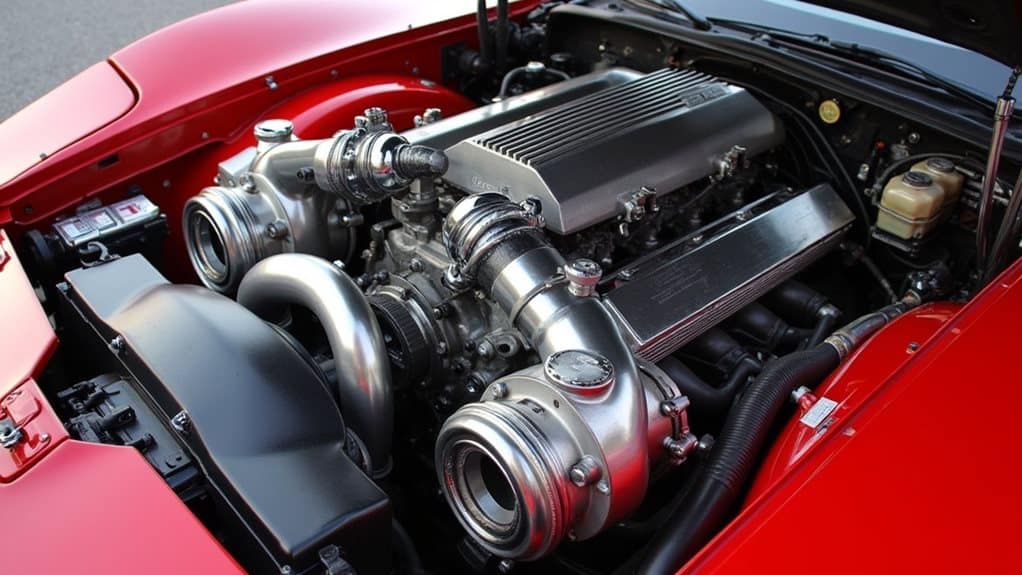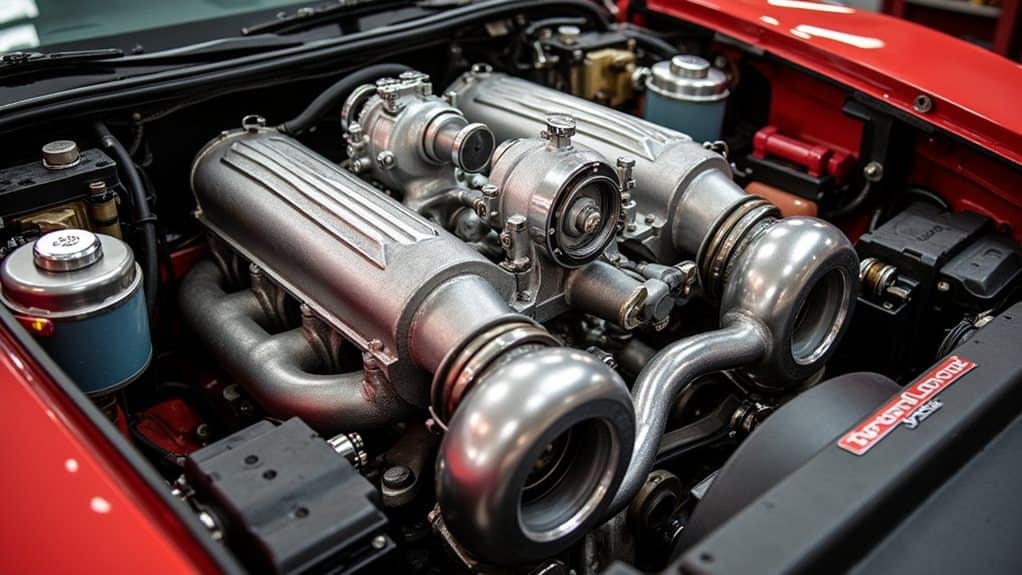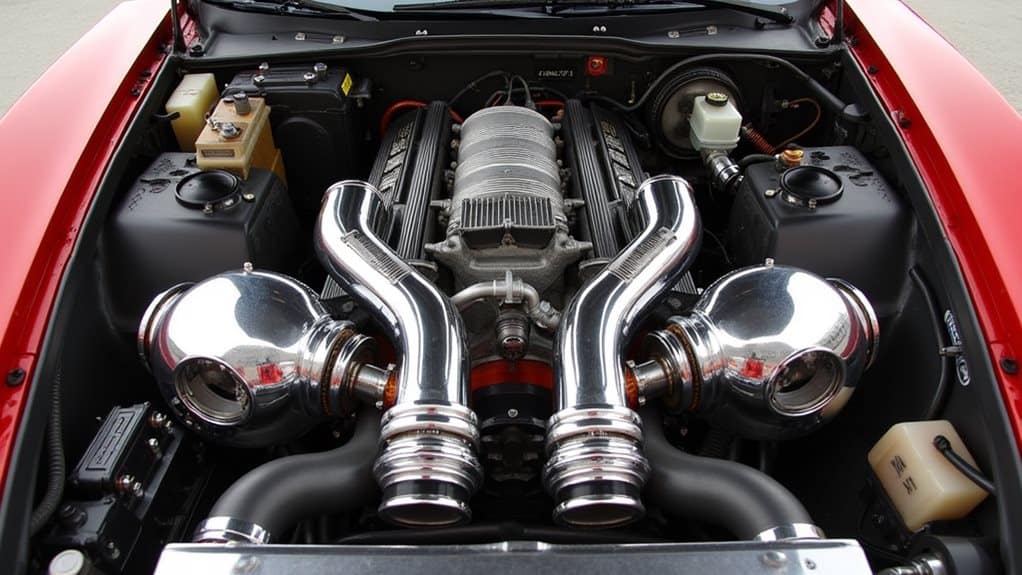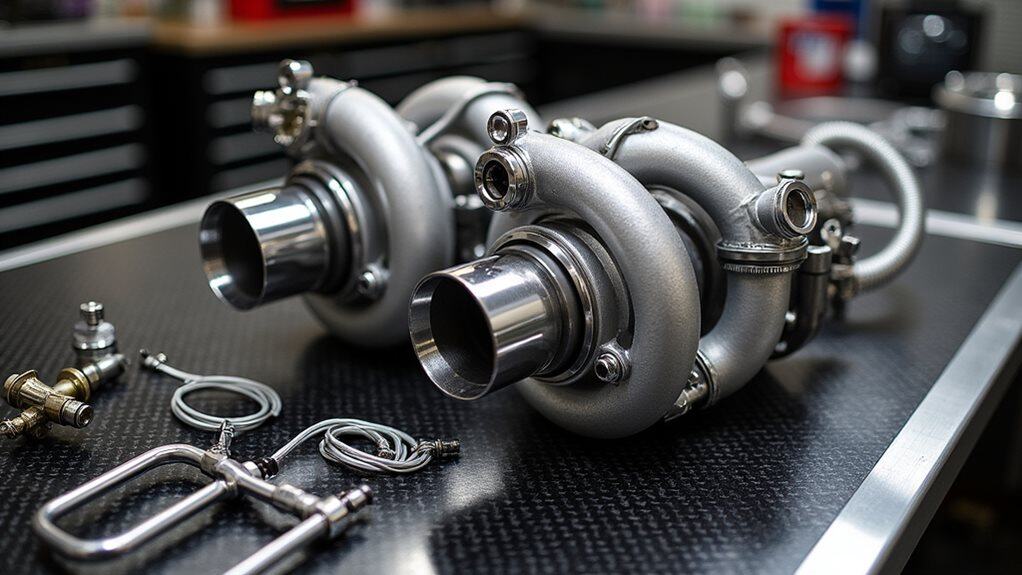Installing a twin turbo kit on your C4 Corvette can yield impressive power gains, with potential increases of 250-425 horsepower at the rear wheels. You’ll need extensive custom fabrication, including exhaust manifolds and precise plumbing, along with vital engine upgrades like forged internals and enhanced cooling systems. While complete kits are available, proper planning for components, safety measures, and power enhancement management is essential. Understanding the full scope of modifications will set you up for successful turbo implementation.
Quick Tips
- Complete twin turbo kits offer easier installation versus sourcing individual parts, with premium packages including all necessary components for installation.
- Proper boost management through calibrated wastegates is essential, with 6 PSI providing 100 horsepower gains and 14 PSI reaching 500 horsepower.
- Engine internals must be strengthened with forged pistons, upgraded connecting rods, and enhanced cooling systems for reliable turbo performance.
- Custom fabrication requires stainless steel materials and precise plumbing, with professional installation recommended for optimal results.
- Monitor boost levels closely and upgrade fuel systems, oil pumps, and transmission components to handle increased power output safely.
Understanding Twin Turbo Basics for C4 Corvettes

Power enthusiasts looking to alter their C4 Corvette’s performance often turn to twin turbo systems as a proven method for substantial horsepower gains.
Your L98 engine can benefit from a 100-horsepower increase with just 6 pounds of pressure, while rear-mount configurations offer a cost-effective installation option. Since there are no off-the-shelf kits available, custom fabrication work will be necessary for installation. Additionally, understanding performance characteristics is crucial to maximizing the benefits of your turbo system.
When you combine turbocharging with TPI enhancements, you’ll achieve even more significant performance improvements.
Custom Fabrication Requirements and Challenges
Since no commercially available twin turbo kits exist for the C4 Corvette, you’ll need to tackle extensive custom fabrication to bring your forced induction dreams to life.
You’ll face challenges like creating custom exhaust manifolds, fabricating precise plumbing, and selecting appropriately sized turbos. For comparison, ProCharger kits offer a complete bolt-on solution without requiring engine modifications. Additionally, ensuring that your setup can support over 650 horsepower is crucial for maximizing performance.
Quality materials, such as stainless steel, and expert welding techniques are essential for building a reliable system that can handle sustained pressure increase.
Essential Engine Modifications for Turbo Installation

Before installing twin turbos on your C4 Corvette, you’ll need to make several critical engine modifications to guarantee reliable performance and longevity.
Start by strengthening your engine’s internals with forged pistons and upgraded connecting rods.
You’ll also need to enhance your cooling system, upgrade the fuel system with larger injectors, and install a high-capacity oil pump for proper lubrication under pressure. Additionally, ensuring that your modifications do not exacerbate head gasket issues is crucial for maintaining engine reliability.
Power Gains and Performance Expectations
With your engine properly modified, you’ll want to understand the realistic performance gains you can expect from a twin-turbo setup.
Running 6 pounds of pressure can add approximately 100 horsepower to your stock L98, while pushing 14 PSI can help you reach 500 HP.
With proper tuning and components like front-mount intercoolers, you’ll see rear-wheel horsepower gains between 250 and 425. Additionally, maintaining proper tire pressure is crucial for maximizing the performance of your upgraded vehicle.
Drivetrain Upgrades to Handle Increased Power

When you’re adding twin turbos to your C4 Corvette, you’ll need to upgrade several key drivetrain components to handle the increased power output.
Your first priorities should be installing a high-performance clutch and beefing up the transmission with reinforced gear sets, as these components will take the initial brunt of the additional torque.
To complete the drivetrain modifications, you’ll want to strengthen your axles with chromoly replacements and upgrade to a performance differential, which will help effectively transfer the increased power to the ground while maintaining reliability.
Essential Clutch and Transmission
The successful installation of a twin-turbo system demands significant upgrades to your C4 Corvette’s drivetrain components, particularly the clutch and transmission systems.
You’ll need to upgrade to a high-performance clutch material and consider a multi-plate design for better heat management.
Don’t forget to reinforce your transmission with stronger gearsets and install an efficient cooling system to handle the increased power output.
Axles and Differential Mods
Powerful twin-turbo upgrades demand strong drivetrain modifications, starting with your C4 Corvette’s axles and differential system.
You’ll need forged steel axles with increased diameter to handle the added torque, along with a limited-slip differential for peak traction.
Consider installing differential cooling systems and reinforced cases, while ensuring proper gear ratios match your power goals and driving style.
Cooling System Modifications and Heat Management
When you’re installing a twin-turbo setup on your C4 Corvette, you’ll need to upgrade the cooling system to handle the increased heat load, starting with a high-capacity aluminum radiator and dual electric fans.
You’ll want to position your intercoolers in the front corners of the engine bay for ideal airflow, while using thermal wraps on your turbo manifolds and downpipes to contain heat.
To combat heat soak, which can rob your turbos of power, you should install a high-flow water pump and consider an air-to-water intercooling system that’s less susceptible to underhood temperatures.
Essential Cooling System Upgrades
Since twin-turbo systems generate substantial additional heat, upgrading your C4 Corvette’s cooling system becomes a critical priority for maintaining engine health and performance.
Start by installing a high-flow water pump with curved vane impellers and an aluminum radiator for improved heat dissipation.
You’ll also want to add dual electric fans, like SPAL’s 2,720 cfm units, paired with composite shrouds for ideal airflow through the radiator core.
Managing Heat Soak Issues
Managing heat soak in your twin-turbocharged C4 Corvette requires an all-encompassing approach to thermal management throughout the engine bay.
You’ll need to install heat shields around your turbos and exhaust components, while adding ceramic coatings to your headers.
Consider implementing phenolic spacers to insulate essential parts, and don’t forget to upgrade your fan system for enhanced post-shutdown cooling performance.
Intercooler Placement Options
Proper intercooler placement stands at the heart of any successful twin-turbo C4 Corvette build, building upon your heat management strategy with targeted cooling solutions.
You’ll want to evaluate a front-mounted setup, which offers ideal airflow while maintaining compatibility with your radiator.
For best results, integrate a dual-core air-to-air intercooler system with high-temp aluminum tubing to maximize cooling efficiency and enhance performance.
Fuel System Requirements and Tuning
Successfully installing a twin turbo system on your C4 Corvette requires significant upgrades to the fuel delivery system and extensive engine tuning.
You’ll need larger fuel injectors, an upgraded fuel pump, and a high-pressure regulator to handle increased power demands.
Additionally, you’ll want to invest in professional dyno tuning and engine management software to guarantee proper air/fuel ratios and prevent engine damage.
Comparing L98 Vs Lt1/Lt4 Engine Compatibility

Beyond fuel system considerations, the choice between L98 and LT1/LT4 engines plays a major role in your C4 Corvette’s turbo setup potential.
While the L98 can handle 5-6 pounds of pressure for roughly 100 extra horsepower, it’ll require extensive custom fabrication.
You’ll find LT1 and LT4 engines are more pressure-friendly, though they’re better suited to supercharging with readily available ProCharger kits rather than turbo setups.
Notable Twin Turbo Success Stories
Early attempts at twin-turbo C4 Corvettes revealed the platform’s extraordinary potential, starting with GM’s own developmental program that produced 14 test vehicles capable of reaching 191 mph.
While GM didn’t pursue commercial production, Callaway stepped in to create 125 highly sought-after twin-turbo Corvettes.
These examples proved that with proper engineering, including upgraded fuel systems and custom fabrication, you’ll achieve outstanding performance gains.
Cost Analysis and Budget Planning

When planning a twin-turbo build for your C4 Corvette, you’ll need to carefully consider both initial investment and long-term costs to guarantee project success.
Complete kits range from budget-friendly eBay options to premium packages costing several thousand dollars.
You’ll save money by choosing a complete kit rather than buying parts separately, though you’ll need to factor in labor costs if you’re not doing the installation yourself.
Safety Considerations and Boost Management
Successful implementation of a twin-turbo setup hinges on proper safety considerations and power management strategies.
You’ll need to monitor pressure closely and install appropriate intercoolers to prevent engine overheating.
Start by upgrading your oil systems and reinforcing engine mounts to handle the increased stress.
Don’t forget to integrate a properly calibrated wastegate for reliable pressure control.
Wrapping Up
Installing a twin turbo kit on your C4 Corvette requires careful planning, thorough research, and precise execution. You’ll need to take into account engine compatibility, fabrication requirements, and necessary supporting modifications to handle the increased power. While the process is complex and costly, you’ll be rewarded with significant performance gains when done correctly. Remember to prioritize safety features and proper pressure management to protect your investment and guarantee reliable operation.

